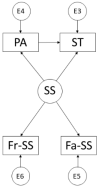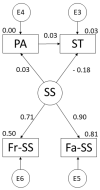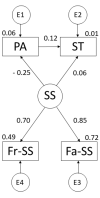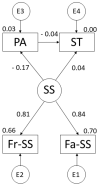An Explanatory Model of the Relationships between Physical Activity, Social Support and Screen Time among Adolescents
- PMID: 35742710
- PMCID: PMC9223611
- DOI: 10.3390/ijerph19127463
An Explanatory Model of the Relationships between Physical Activity, Social Support and Screen Time among Adolescents
Abstract
Effective physical activity studies are necessary to understand how factors involved in physical activity mediate behaviour. Therefore, more reliable explanatory models can be generated in order to design effective actions to promote physical activity. The study had two aims: (1) to develop an explanatory model to identify and establish the relationships between physical activity, social support and screen time among adolescents; and (2) to contrast the explanatory structural model by means of a multi-group analysis according to sex. The study design was cross-sectional with descriptive and correlational analysis. The research was carried out with a representative sample of adolescents from the province of Soria (mean age 14.06 ± 1.27 years). The instruments used were: Four by One-Day Physical Activity Questionnaire, Parent Support Scale and Peer Support Scale. The results show that social support had a negative relationship with screen time (r = -0.178; p ≤ 0.001); males had a positive relationship between physical activity and screen time (r = 0.118; p ≤ 0.05); and peer support had more influence on social support than parental support. In conclusion, the proposed model was effective in triangulating the relationships between physical activity, social support and screen time in a novel way, while allowing us to discriminate these results according to participants' sex.
Keywords: adolescent; gender; physical activity; screen time; social support.
Conflict of interest statement
The authors declare no conflict of interest.
Figures




Similar articles
-
Moderate-Vigorous Physical Activity, Screen Time and Sleep Time Profiles: A Cluster Analysis in Spanish Adolescents.Int J Environ Res Public Health. 2023 Jan 21;20(3):2004. doi: 10.3390/ijerph20032004. Int J Environ Res Public Health. 2023. PMID: 36767372 Free PMC article.
-
Physical Activity, Energy Expenditure, Screen Time and Social Support in Spanish Adolescents-Towards an Explanatory Model about Health Risk Factors.Int J Environ Res Public Health. 2022 Aug 17;19(16):10222. doi: 10.3390/ijerph191610222. Int J Environ Res Public Health. 2022. PMID: 36011855 Free PMC article.
-
Moderate-Vigorous Physical Activity, Family Support, Peer Support, and Screen Time: An Explanatory Model.Int J Environ Res Public Health. 2022 Dec 3;19(23):16177. doi: 10.3390/ijerph192316177. Int J Environ Res Public Health. 2022. PMID: 36498251 Free PMC article.
-
Parental and peer supports are associated with an active lifestyle of adolescents: evidence from a population-based survey.Public Health. 2020 Nov;188:1-3. doi: 10.1016/j.puhe.2020.08.024. Epub 2020 Oct 5. Public Health. 2020. PMID: 33032239
-
The Relationships between Physical Activity, Screen Time and Sleep Time According to the Adolescents' Sex and the Day of the Week.Healthcare (Basel). 2022 Oct 6;10(10):1955. doi: 10.3390/healthcare10101955. Healthcare (Basel). 2022. PMID: 36292402 Free PMC article.
Cited by
-
Predictive Role of Physical Activity and Health-Related Quality of Life in Police Officers' Work Assessment.Eur J Investig Health Psychol Educ. 2024 Jan 29;14(2):299-310. doi: 10.3390/ejihpe14020020. Eur J Investig Health Psychol Educ. 2024. PMID: 38391487 Free PMC article.
-
Mass media pressure on physical build, psychological well-being and physical-healthy profile. An explanatory model in adulthood.PeerJ. 2023 Jan 11;11:e14652. doi: 10.7717/peerj.14652. eCollection 2023. PeerJ. 2023. PMID: 36647449 Free PMC article.
-
Leisure Time Habits and Levels of Physical Activity in Children and Adolescents.Children (Basel). 2024 Jul 21;11(7):883. doi: 10.3390/children11070883. Children (Basel). 2024. PMID: 39062332 Free PMC article.
-
Exercise health belief model mediates the relationship between physical activity and peer support among Chinese college students: A cross-sectional survey.Front Psychol. 2023 Feb 6;14:1103109. doi: 10.3389/fpsyg.2023.1103109. eCollection 2023. Front Psychol. 2023. PMID: 36814667 Free PMC article.
-
Moderate-Vigorous Physical Activity, Screen Time and Sleep Time Profiles: A Cluster Analysis in Spanish Adolescents.Int J Environ Res Public Health. 2023 Jan 21;20(3):2004. doi: 10.3390/ijerph20032004. Int J Environ Res Public Health. 2023. PMID: 36767372 Free PMC article.
References
-
- Rodriguez-Ayllon M., Cadenas-Sánchez C., Estévez-López F., Muñoz N.E., Mora-Gonzalez J., Migueles J.H., Molina-García P., Henriksson H., Mena-Molina A., Martínez-Vizcaíno V., et al. Role of Physical Activity and Sedentary Behavior in the Mental Health of Preschoolers, Children and Adolescents: A Systematic Review and Meta-Analysis. Sports Med. 2019;49:1383–1410. doi: 10.1007/s40279-019-01099-5. - DOI - PubMed
-
- Nyberg S.T., Singh-Manoux A., Pentti J., Madsen I.E.H., Sabia S., Alfredsson L., Bjorner J.B., Borritz M., Burr H., Goldberg M., et al. Association of Healthy Lifestyle With Years Lived Without Major Chronic Diseases. JAMA Intern. Med. 2020;180:760–768. doi: 10.1001/jamainternmed.2020.0618. - DOI - PMC - PubMed
-
- Moore S.C., Lee I.M., Weiderpass E., Campbell P.T., Sampson J.N., Kitahara C.M., Keadle S.K., Arem H., de González A.B., Hartge P., et al. Association of Leisure-Time Physical Activity with Riskof 26 Types of Cancer in 1.44 Million Adults. JAMA Intern. Med. 2016;176:816–825. doi: 10.1001/jamainternmed.2016.1548. - DOI - PMC - PubMed
-
- U.S. Department of Health and Human Services . Physical Activity Guidelines for Americans. 2nd ed. Department of Health and Human Services; Washington, DC, USA: 2018.
MeSH terms
LinkOut - more resources
Full Text Sources
Medical

